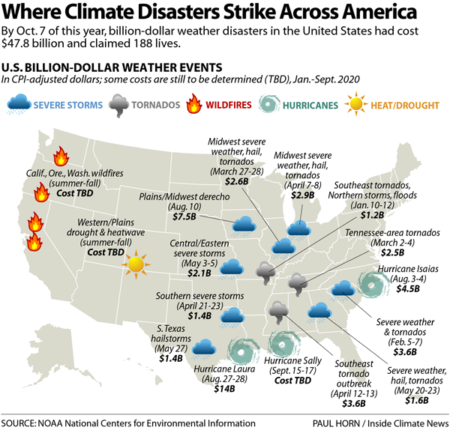January 1, 2021 – Good riddance to 2020. What a year for dealing with natural and human-created global crises. Besides dealing with the global pandemic, anthropogenic climate change played havoc with so many of us. According to NOAA, the U.S. National Oceanic and Atmospheric Administration, as many as 17 billion-dollar extreme weather and climate events have occurred during 2020, almost double the annual standard.
From January to October, the U.S. calculated nearly $50 billion in damages, and 188 lives lost from extreme weather events. These included wildfires, drought, floods, hurricanes, tornadoes, severe storms, and extremes of heat and cold. Compare this to the entire decade of the 1980s with an average of 2.9 events per year costing $17.8 billion annually. Or to the period from 2010 to 2019 which experienced 44 billion-dollar weather events, an average of 11.9 and $81 billion per year.
Of course, the numbers in the U.S. reflect a global phenomenon that is witness to an overall warming of land and ocean temperatures across the planet. The year 2020 as we close it out is currently considered the second warmest in recorded history, finishing slightly behind 2019. The past decade has produced seven of the 10 hottest years for land and ocean temperatures.
For Canada, Alaska, Russia, and the Scandinavian countries, the Arctic is undergoing even more rapid warming with sea ice minimums shrinking to their second-lowest since satellites began monitoring the Arctic Ocean.
Overall, ocean surface temperatures continue to climb which is feeding tropical storm creation and intensity. Hence the Atlantic hurricane season saw 30 hurricanes and tropical storms with 12 making U.S. landfalls.
Even the Antarctic, Greenland, and the Canadian Arctic islands have seen dramatic land-based and ice-shelf melting. In the last few weeks, an iceberg from an Antarctic ice shelf has drifted on a collision course with the remote island of South Georgia in the Southern Ocean. The iceberg is larger than the island itself and could cause an ecological disaster.
A quick review of what the U.S. has experienced in 2020 (November-Decenber not included) follows:
- Western Wildfires – California, Oregon, Washington Firestorms in the late summer and fall of this year burning more than 1.6 million hectares (4.0 million acres) across California including five of the top six largest wildfires on record in the state. Wildfires have destroyed several small towns in California, Oregon, and Washington while smoke has produced hazardous air quality affecting millions across major Western U.S. cities for weeks.
- Western/ Central Drought and Heatwave through the summer and fall included record temperatures in Death Valley, California, exceeding 54 Celsius (130 Fahrenheit). Los Angeles County recorded a high temperature of 49.4 Celsius (121 Fahrenheit). Persistent extreme heat over large population centres combined with drought exacerbated wildfire conditions.
- Hurricane Sally, a Category 2 hurricane, struck the Florida Panhandle, Alabama, and Georgia in September with 75 centimeters (almost 30 inches) of rain, leading to considerable flooding. A slow-moving tropical storm, Sally represented a growing trend in recent years of slow-moving cyclonic events that cause massive storm surges and prolonged precipitation similar to Hurricane Harvey’s prolonged stay over Houston, Texas.
- Hurricane Laura, a Category 4 storm, struck Louisiana producing a 4.5 meter (15-foot) storm surge and winds exceeding 240 kilometers (150 miles) per hour. Laura was the strongest hurricane to hit Louisiana since 1856. Neighbouring states also felt the wrath of the storm.
- The Central States Severe Weather Event saw winds exceeding 160 kilometers (100 miles) per hour traveling 1240 kilometers (770 miles) through South Dakota, Iowa, Illinois, Minnesota, Indiana, and Ohio in late August, causing severe damage to farm crops, homes and businesses and setting off 15 tornadoes with some striking the city of Chicago.
- Hurricane Isaias, a Category 1 storm made landfall in North Carolina in August and subsequently traveled up the Eastern Seaboard causing extensive damage to farms, homes, and buildings in Virginia, Maryland, Delaware, New York, New Jersey, and Pennsylvania, spawning 34 tornadoes.
- South Texas Hail Storms struck South Texas in May with San Antonio and the Waco area taking the brunt of the damage from golf-ball-sized hailstones.
- South, Central and Eastern Severe Weather struck in May in the form of severe thunderstorms, high winds, hail, and tornadoes, affecting Texas, Oklahoma, Arkansas, Indiana, Tennessee, Alabama, Georgia, Florida, South Carolina and Illinois.
- Central and Eastern Severe Weather a separate May event struck from Kansas to South Carolina producing high winds, and hail and causing extensive damage to homes, buildings, and farmland.
- Southern Severe Weather struck in April with high winds, hail and tornadoes across Texas, Oklahoma, Louisiana, Mississippi, Alabama, Georgia, Florida, and Virginia.
- Southeast and Eastern Tornado Outbreak led to 140 twisters alighting in April from Texas to Maryland involving more than a dozen U.S. states.
- Ohio Valley Hail Storms and Severe Weather in April produced 20 tornadoes in Indiana and Ohio and high winds from Missouri to Wisconsin and Iowa to Michigan.
- Midwest and Ohio Valley Severe Weather struck in March across the Midwest and Ohio River Valley from Oklahoma to Pennsylvania and West Virginia, spawning more than two dozen tornadoes and extensive wind damage.
- Tennessee Tornadoes and Southeast Severe Weather struck in March in a separate event with the Nashville metropolitan area taking a direct hit including the international airport. Surrounding states also felt the brunt of high winds, thunderstorms, and multiple tornado events.
- South, East and Northeast Severe Weather in February covered the South, East, and Northeastern States from Louisiana and the Gulf Coast to the New England states with 20 tornadoes touching down across central Mississippi and Tennessee. The extreme weather caused high wind damage from Florida to New Jersey, with the Carolinas and Florida hit the hardest.
- Southeast Tornadoes and Northern Storms and Flooding began the year in January with more than 80 tornadoes and severe thunderstorms striking from the southeastern to northern central and New England states. The intensity of the winds was so severe it caused powerful waves on Lake Michigan causing shoreline and port damage in Milwaukee.
The above 16 events in the U.S. produced more than $50 billion and counting in damages (the full accounting of the western wildfires and drought has not yet been tallied). It is likely the num
















